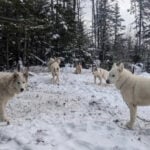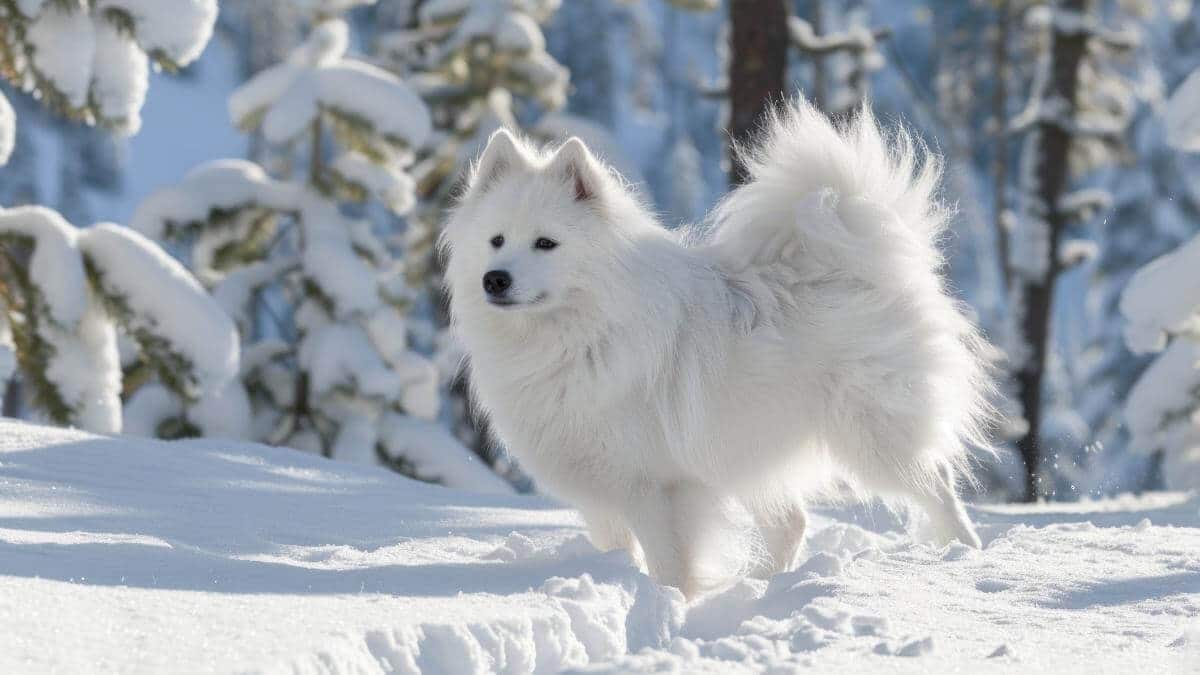


Home » Judging the American Eskimo Dog

This article was originally published in Showsight Magazine, August 2013 issue.
“The American Eskimo Dog is a small to medium-size Nordic dog. There are three separate size divisions of the American Eskimo Dog, Toy (9 inches up to and including 12 inches), Miniature (over 12 inches up to and including 15 inches) and Standard (over 15 inches up to and including 19 inches)—all measurements are height at the withers. All judges should remember that there should be NO PREFERENCE for size, but that every size presented must conform to the Breed Standard. A judge should be prepared to see all sizes together in his or her ring as the American Eskimo Dog is not separated into varieties except in open classes in specialties or in open classes in which a club has been requested to separate the sizes and has agreed to do so. A good example of a miniature American Eskimo Dog. The American Eskimo Dog is a multipurpose working farm dog. A judge should be looking for a dog that is well-balanced, that trots, but does not pace, is agile and can cover the most ground effortlessly.
The dog should appear to float with excellent reach and drive. A good example of reach and drive appears below as Figure 1. Please note that the dog’s front foot is even with the end of his nose. This indicates correct lay back of the shoulder and a deep chest giving this dog the ability to reach correctly. Depth of chest extends approximately to point of elbows. The rear foot is off the ground showing the dog’s ground covering ability as well as his driving ability. This also illustrates well angulated hindquarters and well bent stifes. As speed increases, the American Eskimo Dog will single track with the legs converging toward the center of gravity while the back remains firm, strong and level. Gait is a very important aspect of the American Eskimo Dog. A judge should know that the animal should single track and look for the best specimen that conforms to the standard. When judging the American Eskimo Dog, a judge should always keep the breed standard in mind, whether it be a toy, miniature or a standard. Breed type is always important, but a judge must remember that structure and movement are part of breed type. They must also take into consideration that a dog that appears beautiful and typey standing still might be a totally different type once the judge sees the dog moving. A judge should never compare the American Eskimo dog to the Samoyed. The American Eskimo Dog was never meant to pull sleds.
They were used as guardian, working, herding and companion dogs. Their movement, head type and eye shape are completely different from the Samoyed. Samoyeds pull from the front, American Eskimos drive from the rear. The American Eskimo should have a pronounced stop, whereas the Samoyed has more of a slope. The eye of the American Eskimo is slightly oval, not oblique as is the eye of the Samoyed. The American Eskimo has a very distinctive coat. It is a stand-off double coat consisting of a dense undercoat. It should be straight with no curl or wave. THERE IS TO BE NO TRIMMING OF THE WHISKERS OR BODY COAT AND SHOULD BE SEVERELY PENALIZED. Figure 2 is a picture of the correct American Eskimo coat that is labeled to show a judge what to look for and to avoid putting up a trimmed dog. It should also be noted that females do not carry as much coat as males. Figures 3 and 4 are pictures of excellent females that are not carrying as much coat as Figure 2, but are still in correct coat. Another important aspect of the American Eskimo Dog that a judge should consider is length of neck. Adequate length of neck that blends naturally into the shoulder indicates a strong shoulder lay back. Lay back of the shoulder contributes to the amount of reach a judge will or will not see.
The neck should have a strong graceful arch blending into a level top line. The following photo shows an animal with the correct length of neck and correct pigment. Judges should never consider the American Eskimo Dog a “head” breed. The head is a Nordic type head, slightly crowned and slightly wedge shaped with widest breadth between the ears which should conform to the head size and be triangular, slightly blunt tipped and held erect, set on high yet well apart. Eyes are dark to medium brown and slightly oval. The presence of tear stains, unless severe, should not be faulted. The standard calls for a full complement of teeth which should be considered when judging. The American Eskimo must have a keen, intelligent and alert expression, The following depicts the correct head type. Judges should also be able to recognize the difference between snow nose and absence of pigment. A dog that is kept inside all of the time and is not exposed to the sunlight may often develop lightening of the nose or as more commonly known as a “snow nose.” Those dogs will have a black line all around the nose leather and may even have a few black spots on the faded nose. This phenomena also occurs in some American Eskimos as they age.
Further, a dog with a snow nose will not have any fading of the eye rims or the lips. Absence of pigment means that the nose is pink with total absence of black and some possible absence on the lips and eye rims as well. It should be noted that the head is only part of the total dog combined with structure and movement. One important thing for a judge to note is that white is the preferred color, but white with biscuit cream is permissible. If a judge must choose between a pure white dog of lesser quality, than a dog with biscuit cream, the judge must choose the biscuit cream dog due to its quality in regard to type, structure and movement. Breeders have been striving for many years to present an animal with a temperament deserving of the breed. American Eskimo Dogs should be intelligent, alert and friendly, although slightly conservative. It is never overly shy or overly aggressive. A judge needs to remember that the breed is conservative. A judge should not approach an American Eskimo Dog from the rear, bend over or touch a dog on the floor, especially if the judge is a man that is over 6 feet tall or should they approach a dog on the table completely out of the animal’s peripheral vision. American Eskimo Dogs were originally used for protection of their home and family.
The dog will form this protective bond with its owner/handler or its handler. It is very important that a judge take this into consideration so as not to startle the dog. The American Eskimo will not threaten to bite or attack, but may show its conservatism if startled which may convey the wrong message to the judge. It is of immense importance that judges be aware of the temperament expected by responsible breeders whether it be the American Eskimo Dog or any other breed for that matter. I was asked to define the perfect American Eskimo Dog. As we all know, there is no perfect dog. I would love to see a perfect Nordic head with the ears and oval eyes the proper width apart, a good stop that is not abrupt, beautiful black points and a good bite than conforms to the breed standard. Structure and movement are very important to me, so my perfect dog would have a great length of neck tapering into a well laid back shoulder with a level top line. The rear would be well angulated with well bent stifes and well let down pasterns. The tail would be set moderately high and would reach the point of hock when down. The coat would be full and luxurious and not trimmed. The perfect dog would have tight feet, with reach and drive to die for. Most importantly to me, he would be able to single track on a dime and never put a foot wrong. That is my idea of a perfect American Eskimo Dog.”